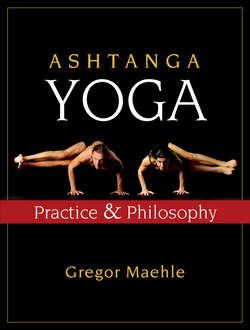Читать книгу Ashtanga Yoga - Gregor Maehle - Страница 23
На сайте Литреса книга снята с продажи.
The Yogic Approach
ОглавлениеThe Ashtanga Vinyasa Yoga practice is a movement meditation. The goal is that every breath taken becomes a conscious one. The set sequence, the consistent flow, the internal holding of the bandhas, the drishti, and listening to the sound of the Ujjayi pranayama are all techniques designed to withdraw the senses.
This facilitates focused concentration so that meditation becomes possible. Absence of the Ujjayi sound, shallow breathing, and fidgeting usually indicate that the mind has taken over and focus has been lost.
In the Yoga Sutra, Patanjali gives three stanzas on asana.1 Their simplicity is profound.
Posture is steadiness and ease.
True posture is then when effort ceases and meditation on infinity occurs.
In asana there is no assault from the pairs of opposites.
Posture is steadiness and ease.
This stanza describes the qualities of posture. Steadiness implies effort and strength. Ease implies relaxation and release. These opposites are complementary. The effort required to build a strong body produces steadiness and gives ease of posture.
True posture is then when effort ceases and meditation on infinity occurs.
The ultimate aim of any limb of yoga is for us to experience our true nature. In practice, and in the following descriptions of how to perform each posture, sensitivity, awareness, and heightened concentration are demanded. Eventually, when the posture is known, we can drop the details and “be” in the posture. Effort ceases; the posture is expressed from within; meditation on infinity occurs. Infinity is a quality of our true nature.
In asana there is no assault from the pairs of opposites.
Steadiness and ease are themselves a pair of opposites, and yet, when in balance, each supports and allows the other to express itself fully. With excess effort the body becomes insensitive and the mind agitated. With excess ease the body becomes sluggish and the mind dull. Both aspects of this duality must be embraced. In his book Awareness through Movement, Moshe Feldenkrais points out that, if one lifts an iron bar and a fly alights on it, no difference can be noticed. If, however, you hold a feather you will notice if a fly lands on or takes off from it. With excess effort there is no room for improvement, as full effort has already been exerted. Sensitivity reserves the space to observe differences, to adapt the posture and to learn. In the space between the opposites, the mind falls still.
